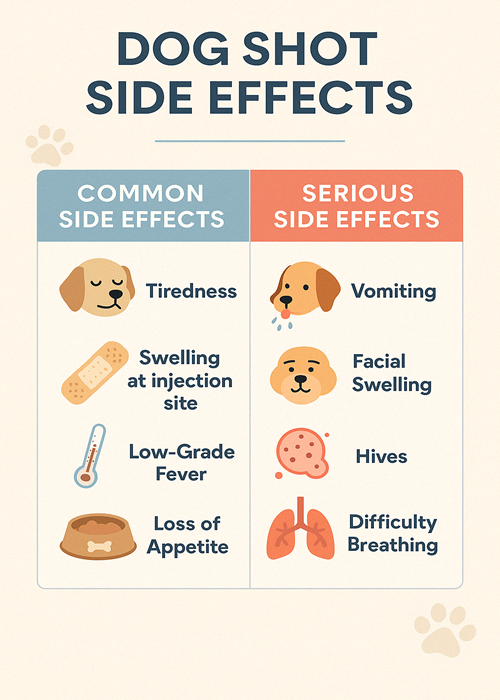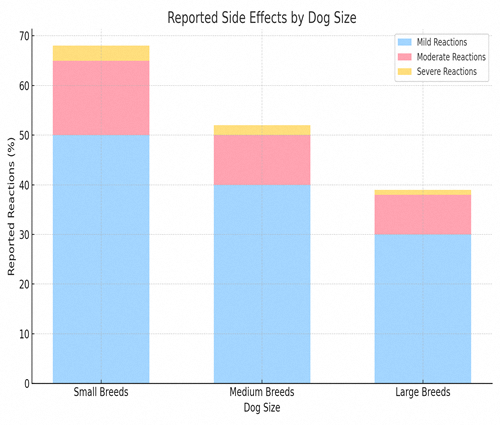Dog Shots Side Effects: What Vets Don’t Always Tell You

Every year, millions of dog owners take their furry friends to the vet for vaccinations, trusting the process as a routine part of responsible pet care. But while vaccines are essential for disease prevention, the conversation around dog shots side effects is often far too brief—if it happens at all. Most vets will tell you that side effects are “rare” or “nothing to worry about,” yet many pet owners find themselves blindsided when their dog starts behaving differently or reacting unexpectedly after a shot.
Understanding both the benefits and the risks of dog vaccinations isn’t about being anti-vax—it’s about being informed. In this article, we’re breaking the silence on vaccine side effects in dogs, highlighting what’s commonly experienced, what’s rarely mentioned, and what you as a pet parent need to watch out for.
The Vital Role of Vaccines—And Their Unspoken Costs
Vaccines are one of the cornerstones of modern veterinary care. They protect dogs from life-threatening diseases like rabies, parvovirus, distemper, and leptospirosis, many of which are still prevalent in some parts of the world. These shots help not only your dog but also contribute to herd immunity, reducing the spread of disease to other pets and even humans.
That said, no medical procedure is entirely without risk. Just like in human medicine, dog vaccines can come with side effects—some minor, some more serious. The challenge? These potential reactions are often downplayed, leaving owners underprepared. By shedding light on both the expected and unexpected, we give ourselves the power to make smarter, safer choices for our pets.
What Happens After the Jab? Common Reactions
For most dogs, vaccinations result in nothing more than a sleepy afternoon and maybe a tender spot at the injection site. Mild side effects like slight lethargy, temporary loss of appetite, and low-grade fever are typical and generally resolve within a day or two. These are considered normal signs that the immune system is doing its job, processing the vaccine and building resistance.
However, when these symptoms linger, worsen, or come with added issues—such as muscle stiffness or behavioral changes—it’s worth taking a second look. Some dogs might whimper when touched, hide under furniture, or appear anxious and disoriented. While vets might dismiss this as temporary discomfort, many pet parents find it unsettling and feel unprepared for how to respond.
The Rare but Serious Side Effects Vets Often Skip
While rare, more concerning side effects can occur. Allergic reactions to vaccines, especially within the first few hours, can lead to vomiting, diarrhea, swelling of the face or throat, and even difficulty breathing. This condition, known as anaphylaxis, requires immediate medical attention. Unfortunately, these severe side effects are usually glossed over during vet visits unless you specifically ask about them.
Other longer-term reactions that have been reported—though infrequent—include immune system disorders, joint inflammation, and seizures. The connection between vaccines and chronic illness is still debated in the veterinary world, but some researchers and holistic vets suggest a cautious, case-by-case approach rather than blanket vaccine schedules. This includes looking into specific concerns such as the dog side effects of rabies vaccine, which has drawn attention for triggering more intense reactions in some sensitive dogs.
Why Don’t Vets Talk About This More?
Veterinarians walk a fine line. On one hand, they want to encourage compliance with core vaccinations because public health depends on it. On the other, discussing every potential side effect—even the rarest—could alarm pet owners and lead to vaccine hesitancy. Additionally, time constraints during routine visits don’t always allow for in-depth conversations about risk versus reward. That’s why it’s important for you, as a dog parent, to come armed with questions and to advocate for your pet’s unique needs.
Not all dogs are the same. Breed, size, age, and health history all play roles in how a dog may react to shots. Some smaller breeds or dogs with autoimmune issues, for example, are more likely to have vaccine-related complications. In those cases, the default schedule may need to be revisited.
What You Can Do to Minimize the Risks
The best thing you can do is stay proactive. Before your dog’s appointment, make a list of any past vaccine reactions, unusual health episodes, or allergies. Discuss these with your vet and don’t hesitate to ask about titer testing—this is a blood test that checks whether your dog still has immunity from previous vaccinations, and it might help avoid unnecessary boosters.
After the shot, keep a close eye on your dog for at least 72 hours. Watch for vomiting, swelling, hives, or behavioral shifts. Keep your vet’s contact handy and trust your instincts—if something seems off, speak up.
If you’re curious about specific vaccine types, such as those that frequently raise concerns, our related guide on Dog Side Effects of Rabies Vaccine covers in-depth what to expect and how to handle rare reactions from one of the most mandated vaccines globally.
The Bigger Picture: Vaccination Is a Tool, Not a Rule
Vaccines are powerful. They have saved countless canine lives and reduced outbreaks of deadly diseases across the globe. But like any powerful tool, they should be used wisely. That means tailoring vaccine schedules to the individual dog, staying informed, and not being afraid to ask your vet the tough questions.
The more we understand about dog shots side effects, the better choices we can make—not out of fear, but out of love. Because protecting your dog’s health goes beyond just getting the shots. It means knowing what could happen afterward and being ready to support them every step of the way.
Key Takeaways
- Vaccinations are essential, but dog shots side effects—even mild ones—are more common than some vets let on.
- Mild side effects like fatigue or swelling are typical and usually go away quickly.
- Serious reactions, such as allergic responses, are rare but require immediate attention.
- Breed, size, and health status all impact how your dog might respond to vaccines.
- Always monitor your dog closely after vaccinations, especially within the first 72 hours.
- Titer testing and delayed schedules may be valid options for some dogs—ask your vet.
- Stay informed, ask questions, and make personalized decisions based on your dog’s unique needs.
FAQs
1. What are the most common dog shots side effects?
The most common side effects of dog vaccinations are usually mild and short-lived. These include slight lethargy, low-grade fever, swelling or tenderness at the injection site, and occasional loss of appetite. Your dog might be a little sleepier than usual, or prefer to be left alone for a while after getting vaccinated. These are generally signs that the immune system is responding to the vaccine as intended. If the symptoms persist for more than 48 hours or appear to worsen, it’s a good idea to contact your veterinarian for guidance.
2. How soon do side effects from dog vaccines appear?
Most side effects tend to develop within the first few hours after your dog receives a vaccine—especially within the 2 to 24-hour window. In some cases, dogs can show signs like localized swelling or mild behavioral changes almost immediately. More severe reactions, such as vomiting or facial swelling caused by allergic responses, can occur in as little as 15–30 minutes. That’s why many vets recommend staying in the clinic waiting area for 15–20 minutes post-vaccine, especially if your dog has a history of sensitivities.
3. Can a dog have a delayed reaction to vaccines?
Yes, delayed reactions can and do occur, though they are less common than immediate ones. Some dogs may exhibit side effects like joint stiffness, mild limping, or loss of appetite a few days after vaccination. In rare cases, more serious symptoms may develop up to a week later, particularly with vaccines that trigger stronger immune responses like the rabies vaccine. If your dog shows unusual symptoms days after a shot—such as behavioral changes, lethargy, or swelling—don’t assume it’s unrelated. Call your vet to discuss possible connections and treatment options.
4. Are small dog breeds more prone to vaccine side effects?
Small dog breeds, such as Chihuahuas, Yorkies, and Pomeranians, often experience stronger post-vaccine symptoms compared to larger breeds. This is largely because vaccines are usually administered in standard doses, regardless of the dog’s size, which means small dogs receive a comparatively higher dose per pound. These reactions can include prolonged lethargy, digestive upset, or even allergic responses. If you have a toy or miniature breed, talk to your vet about spacing out vaccines, using single-dose options, or monitoring your pet longer after each injection to reduce the risks.
5. Are rabies vaccines more likely to cause side effects?
Rabies vaccines are legally required in many regions, and they tend to be among the most potent vaccinations your dog will receive. Some dogs, particularly those with immune sensitivities or a history of allergies, may experience stronger side effects after a rabies shot. These can range from mild reactions like fatigue or swelling, to more concerning issues like facial swelling, vomiting, or even temporary behavior changes. If you’re concerned, speak with your vet about whether a three-year rabies vaccine option is appropriate for your dog. You can also read our full article on Dog Side Effects of Rabies Vaccine for an in-depth breakdown.
6. Can I skip or delay vaccinations if I’m worried about side effects?
While skipping core vaccines entirely is not recommended—especially for diseases like rabies, which are legally required in many areas—there are safer alternatives for dogs with sensitivities. One option is titer testing, which measures your dog’s existing immunity and can help determine whether a booster is truly necessary. Another approach is to delay or space out non-core vaccines, especially for puppies or smaller breeds. Ultimately, decisions should be made with your vet, balancing your dog’s lifestyle, medical history, and exposure risk. The key is to prioritize your dog’s individual health, not just follow a one-size-fits-all schedule.












